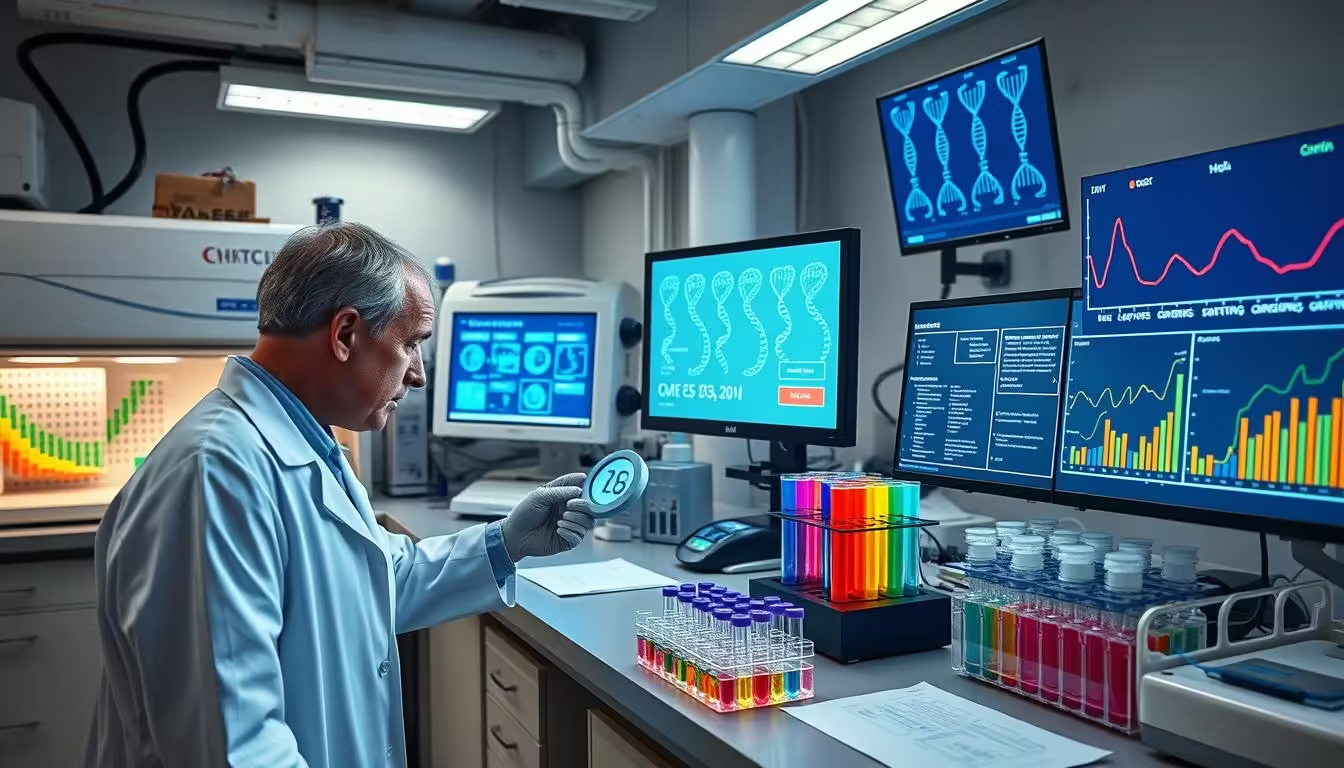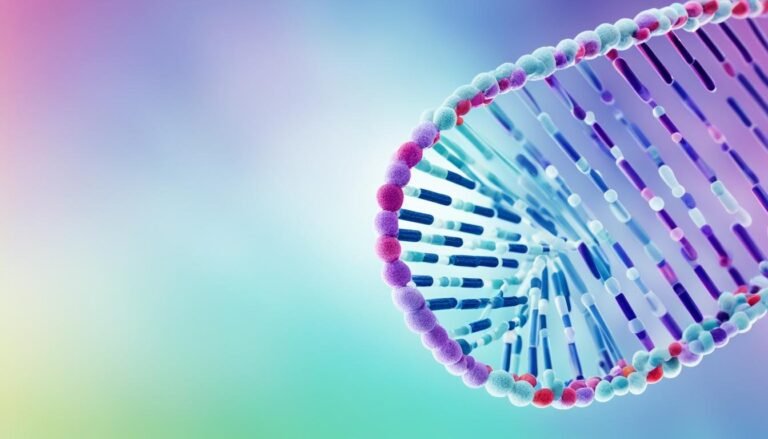Pharmacogenomics and Rare Diseases: Bringing Hope to Orphan Drug Development
Rare diseases are a significant global health challenge, affecting millions worldwide. In the US, 30 million people, and in the EU, 36 million, face over 7,000 rare diseases, with 80% being genetic1. The impact is especially harsh on children, with half of those affected being young. Sadly, 3 out of 10 children with a rare disease do not survive beyond their fifth birthday1.

The field of pharmacogenomics offers hope in rare disease research and treatment. With over 80% of rare diseases being genetically-based, the Human Genome Project’s completion in 2003 was a crucial step forward2. This convergence of genetics and pharmacology has opened new avenues for orphan drug development, offering potential solutions to long-neglected conditions.
The economic and societal burden of rare diseases is immense. The average cost to society for 24 rare diseases in the US is $266,000 per patient per year, roughly 10 times higher than common diseases1. This financial strain, combined with the limited market size for rare genetic diseases, has historically deterred investment in this critical area of medical research.
Despite these challenges, progress is being made. The last 10-15 years have seen the most successful period of development for orphan drugs, with over 400 such medications developed and marketed in the US since the Orphan Drug Act of 19832. This progress brings hope to millions of patients and families affected by rare diseases, marking a new era in personalized medicine and targeted therapies.
Understanding Rare Diseases: Definitions and Challenges
Rare diseases are medical conditions affecting a small percentage of the population. In the United States, a rare disease is defined as one impacting fewer than 200,000 people. Despite their rarity, these conditions collectively affect 20 to 30 million Americans, placing a significant burden on society3.
Global Prevalence and Impact
The global impact of rare diseases is staggering. Approximately 7,000 rare diseases have been identified, affecting millions of individuals worldwide3. The National Institutes of Health’s Undiagnosed Disease Program has received nearly 10,000 inquiries and admitted around 900 patients for comprehensive evaluations, underscoring the complexity of rare disease diagnostics4.
Economic and Societal Burdens
The economic burden of rare diseases is substantial. Limited research funding and challenges in participant recruitment contribute to the high costs associated with rare disease research and treatment. Genetic testing, a crucial component of rare disease diagnostics, often comes with significant expenses.
Complexities in Diagnosis and Treatment
Diagnosing rare diseases presents unique challenges. Out of the 7,000 identified rare diseases with known molecular causes, only about 500 have approved treatments4. Advancements in genetic testing, such as whole-genome and exome sequencing, are improving diagnosis accuracy. Long-read sequencing techniques, like HiFi sequencing, offer better resolution of complex genes compared to short-read methods, crucial for understanding genetic disorders5.
The role of pharmacogenomics in personalized medicine is becoming increasingly important in addressing the unique needs of rare disease patients. As research progresses, the hope is that more effective treatments will become available, improving the lives of those affected by rare diseases.
The Evolution of Orphan Drug Policies
The treatment landscape for rare diseases has undergone significant transformation with the advent of orphan drug policies. These legislative frameworks aim to incentivize the development of drugs for conditions affecting small patient populations.
The US Orphan Drug Act of 1983
The US Orphan Drug Act of 1983 was a pivotal moment in rare disease legislation. It introduced special regulatory pathways and incentives, such as grant funding, tax credits, and market exclusivity. These measures were designed to encourage research into unmet medical needs6. This groundbreaking policy has led to the development and marketing of over 400 orphan drugs in the U.S7.
International Adoption of Orphan Drug Legislation
Following the U.S. lead, other countries have adopted similar rare disease legislation. These policies have fostered global interest in orphan drug development. Nearly 200 orphan drugs enter development each year in the U.S. alone7. The international scientific community has shown growing interest in niche markets and personalized medicine approaches for rare diseases8.
Impact on Rare Disease Drug Development
Orphan drug policies have profoundly influenced pharmaceutical research and development. Approximately one-third of new drugs approved by the FDA now target rare diseases7. However, concerns have been raised about potential exploitation of these designations for greater revenues6.
Orphan drug laws have revolutionized rare disease research, but challenges remain in ensuring equitable access and addressing all rare conditions.
The impact of these policies is evident in the growing number of orphan drugs reaching the market. Yet, questions persist about their focus, with oncology-related rare diseases accounting for a significant portion of designations and approvals6. As the field evolves, pharmacogenomics is playing an increasingly crucial role in orphan drug development. Over 80% of rare diseases are estimated to have a genetic basis7.
| Aspect | Before Orphan Drug Act | After Orphan Drug Act |
|---|---|---|
| Number of Orphan Drugs Marketed | Few | Over 400 |
| Annual Orphan Drug Entries | Minimal | Nearly 200 |
| FDA Approvals for Rare Diseases | Low percentage | About 33% |
| Focus on Pharmacogenomics | Limited | Significant increase |
Pharmacogenomics and Rare Diseases: A Promising Intersection
Pharmacogenomics is pivotal in rare disease research, merging genomic data with clinical insights to boost treatment outcomes for complex conditions such as cancer9. This synergy is especially crucial given that over 80% of rare diseases stem from genetic mutations.
In the US, genetic screening aids in predicting and diagnosing critical conditions, thereby enhancing patient outcomes and lowering morbidity rates9. The Human Genome Project’s inception has fueled interest in aligning pharmaceuticals with diagnostic tests, marking a significant milestone in personalized medicine.
Advances in DNA sequencing and electronic medical records have streamlined the sharing and analysis of genomic data9. This development enables researchers to segment broader disease categories into more specific genotypes, thereby opening new therapeutic avenues.
Theragnostics, a fusion of therapeutics and diagnostics, leverages diverse biomarkers10. This method is essential for crafting personalized treatments for rare diseases. Nonetheless, debates surrounding gene patents and the ethical implications of theragnostic testing, especially in individualized drug therapy, have surfaced10.
Many pharmacogenomic drugs have secured orphan drug status, albeit they constitute a minor portion of total orphan drug designations. The CDC is actively researching genome-wide genotyping data to explore the nexus between pharmacogenomics and birth defect risk11. Such research could profoundly influence rare disease treatment and prevention strategies.
| Aspect | Impact on Rare Diseases |
|---|---|
| Genetic Screening | Improves diagnosis and prediction |
| Personalized Medicine | Enhances treatment efficacy |
| Theragnostics | Integrates biomarkers for targeted therapies |
| CDC Research | Studies pharmacogenomics in birth defects |
As pharmacogenomics evolves, it holds the promise of offering hope to millions grappling with rare diseases. It heralds a new era of more effective, tailored treatments.
The Role of Genetic Testing in Rare Disease Diagnostics
Genetic testing has emerged as a vital tool in diagnosing rare diseases. Advances in genomic sequencing technologies offer new avenues for patients seeking clarity. The Deciphering Developmental Disorders study found diagnoses for about 41% of probands with severe developmental disorders in the UK and Ireland12.
Advancements in Genomic Sequencing Technologies
The 100,000 Genomes Project in England reported diagnostic yields of 40-55% for intellectual disability, hearing, and vision disorders. It achieved a 25% diagnostic rate overall12. These advancements are making rare disease diagnostics more accessible and accurate.

Challenges in Interpreting Genetic Data
Despite progress, interpreting genetic data for rare diseases remains complex. Researchers are working to identify rare pathogenic variants in human genomes to enhance diagnostics13. This task is daunting due to the vast amount of data and limited knowledge about many rare conditions.
Ethical Considerations in Genetic Testing
Ethical issues surround genetic testing for rare conditions. Rapid genomic testing for critically ill children has shown transformative outcomes, but it also raises concerns12. Parents of pediatric patients often experience a range of emotions, including relief, fear, and frustration, particularly with rare diagnoses12.
Moreover, uptake of genomic testing among minority ethnic groups is lower than expected. Concerns about discrimination and healthcare disparities affect acceptance12. These issues underscore the need for culturally sensitive approaches in rare disease diagnostics.
As genetic testing continues to evolve, it promises to revolutionize rare disease diagnostics. However, addressing ethical concerns and improving data interpretation remain crucial challenges in this field.
Targeted Therapies: Precision Medicine for Rare Diseases
Targeted therapies are transforming rare disease treatment through precision medicine. These treatments are personalized, taking into account each patient’s genetic makeup. This ensures maximum drug efficacy and safety. Pharmacogenomics, the study of how genes influence drug responses, is essential in this field.
The advent of targeted therapies has significantly advanced orphan drug development. Each year, nearly 200 orphan drugs begin development, offering new hope to those with rare conditions14.
Regulatory bodies now treat pharmacogenomic products like other orphan drugs. This recognition has facilitated the development of treatments tailored to specific genetic profiles. Consequently, we are witnessing a shift towards more effective and safer therapies for rare disease patients.
“Precision medicine is not just about treating diseases; it’s about treating individuals.”
Recent studies have highlighted the potential of targeted therapies. For example, researchers have successfully modeled rare diseases using induced pluripotent stem cell technology15. Direct reprogramming strategies have also enabled the creation of patient-specific induced neuronal cells. These tools are invaluable for studying rare neurological disorders15.
The convergence of pharmacogenomics and rare diseases is driving innovation in treatment strategies. By combining genomic data with clinical information, researchers can identify biomarkers for drug responses. This approach has led to significant advancements in cancer therapy, where basket and umbrella trials are becoming more prevalent14.
As precision medicine advances, it promises to revolutionize rare disease care. By utilizing genetic insights and targeted therapies, we are moving towards a future where every patient receives the most effective treatment. This treatment will be tailored to their unique genetic profile.
Overcoming Barriers in Orphan Drug Development
Orphan drug development encounters unique hurdles in addressing rare diseases. The pharmaceutical sector faces challenges due to the limited market size and economic obstacles in this niche area.
Limited Market Size and Economic Challenges
The rarity of these conditions poses a significant challenge. With an estimated 4000 to 5000 rare diseases globally, patient populations for each disorder are minuscule16. This scarcity elevates the cost and complexity of clinical trials, discouraging many companies from investing in orphan drug development.
Scientific Complexities in Rare Disease Research
Rare diseases often involve intricate biological mechanisms, complicating research efforts. Gene editing technologies, such as CRISPR/Cas9, are transforming treatment approaches for genetic disorders17. Zinc Finger Nucleases and Transcription Activator-like Effector Nucleases hold promise in correcting specific genetic abnormalities in diseases like Hemophilia B and X-linked Severe Combined Immunodeficiency17.
Regulatory Hurdles and Incentives
To counteract market challenges, governments implement regulatory incentives. These include tax credits, research grants, simplified marketing authorization procedures, and extended market exclusivity16. Despite these efforts, concerns about potential misuse and the need to prioritize diseases with the greatest unmet medical needs persist.
| Challenge | Solution |
|---|---|
| Limited patient populations | AI-driven patient identification |
| High development costs | Government incentives and grants |
| Complex disease mechanisms | Advanced gene editing technologies |
| Drug delivery issues | Nanoparticle-based delivery systems |
Innovative solutions are emerging to address these challenges. Artificial Intelligence is revolutionizing drug discovery and identifying repurposing opportunities for rare diseases17. Advanced drug delivery systems, such as liposomes and nanoparticles, are enhancing targeting for conditions like Fabry Disease and Niemann-Pick Disease Type C117. These advancements offer hope for overcoming the barriers in orphan drug development and providing relief to patients with rare diseases.
Biomarkers and Personalized Treatment Approaches
Genomic biomarkers are revolutionizing the treatment of rare diseases. They enable the identification of patient subgroups most likely to benefit from targeted therapies. The integration of proteomics, transcriptomics, and metabolomics into pharmacogenomics has significantly broadened the field18.
Identification of Genomic Biomarkers for Rare Diseases
The FDA’s approval of personalized treatments involving biomarkers is witnessing a rapid increase18. By 2018, the FDA had approved 355 pharmacogenomic biomarkers and 284 drugs19. This surge underscores the pivotal role of genomic biomarkers in drug development.
Tailoring Drug Dosages Based on Pharmacogenomic Profiles
Pharmacogenomic profiles enable the customization of drug dosages. This method optimizes treatment efficacy while minimizing adverse effects. Genetic variations in enzymes, transporters, and receptors are now recognized as clinical biomarkers18. These markers play a crucial role in drug metabolism and pharmacokinetics.
Personalized medicines are applied in various conditions, including cancer, neuropsychiatric diseases, infections, and cardiovascular conditions19. For instance, lung cancer patients treated with ramucirumab must possess specific genetic mutations for the drug to be effective19. This precision enhances drug efficacy and improves patient outcomes.
Predicting and Mitigating Adverse Drug Reactions
Adverse drug reactions are a leading cause of hospitalizations. Pharmacogenomic approaches facilitate the prediction and mitigation of these reactions. Ongoing research aims to identify genetic variants that influence susceptibility to adverse drug reactions18. This research is crucial for enhancing patient safety and treatment efficacy.
“Personalized medicine is not just about treating diseases; it’s about treating individuals.”
The future of rare disease treatment hinges on these personalized strategies. By combining genomic biomarkers with tailored drug dosages, we can offer hope to those living with rare conditions.
Collaborative Efforts in Rare Disease Research
The intricate nature of rare diseases necessitates a collective approach in research and drug development. Research collaboration has become essential in tackling the unique hurdles posed by small patient populations and limited resources. Patient advocacy groups, pharmaceutical companies, and academic institutions are coming together to expedite advancements in this field.
Rare disease networks are pivotal in linking researchers, clinicians, and patients globally. These networks enable data sharing, facilitate larger patient cohorts for clinical trials, and promote knowledge exchange. The International Rare Diseases Research Consortium exemplifies this model, prioritizing patient involvement and resource collaboration to improve diagnosis and therapy development20.
Patient advocacy has become a significant force in shaping rare disease research priorities. Organizations like Fondazione Telethon ETS have been pivotal in funding studies and securing access to treatments. These groups not only raise awareness but also actively engage in drug research and licensing processes, ensuring patient needs are central to development efforts20.
Regulatory bodies are evolving to support collaborative efforts in rare disease research. The FDA has issued guidance on efficient pre-investigational new drug application meetings for rare disease products, promoting a collaborative drug development approach in pediatric rare diseases21. These initiatives, along with public-private partnerships and international research networks, are vital in overcoming the challenges of limited expertise and resources in individual rare diseases, offering hope to millions affected by these conditions.
Source Links
- Frontiers | Unlocking the full potential of rare disease drug development: exploring the not-for-profit sector’s contributions to drug development and access – https://www.frontiersin.org/journals/pharmacology/articles/10.3389/fphar.2024.1441807/full
- Orphan drug incentives in the pharmacogenomic context: policy responses in the US and Canada – https://www.ncbi.nlm.nih.gov/pmc/articles/PMC5034370/
- Drug discovery and development for rare genetic disorders – https://www.ncbi.nlm.nih.gov/pmc/articles/PMC5662129/
- Rare Diseases – https://www.nih.gov/about-nih/what-we-do/nih-turning-discovery-into-health/promise-precision-medicine/rare-diseases
- Understanding rare diseases: why research matters – PacBio – https://www.pacb.com/blog/understanding-rare-diseases-why-research-matters/
- Orphan drug incentives in the pharmacogenomic context: policy responses in the USA and Canada – https://www.ncbi.nlm.nih.gov/pmc/articles/PMC5033429/
- Orphan drug incentives in the pharmacogenomic context: policy responses in the US and Canada – https://academic.oup.com/jlb/article-abstract/2/2/263/826087
- Potential Interactions of the Orphan Drug Act and Pharmacogenomics: A Flood of Orphan Drugs and Abuses? | American Journal of Law & Medicine | Cambridge Core – https://www.cambridge.org/core/journals/american-journal-of-law-and-medicine/article/potential-interactions-of-the-orphan-drug-act-and-pharmacogenomics-a-flood-of-orphan-drugs-and-abuses/5527149E08296CF1F66638FD2A30DA60
- Artificial Intelligence, Healthcare, Clinical Genomics, and Pharmacogenomics Approaches in Precision Medicine – https://www.ncbi.nlm.nih.gov/pmc/articles/PMC9299079/
- Shifting emphasis from pharmacogenomics to theragnostics – https://www.ncbi.nlm.nih.gov/pmc/articles/PMC7096916/
- Genomics and Precision Health Blog – Archive | Blogs – https://blogs.cdc.gov/genomics/page/5/
- Genomic testing for rare disease diagnosis—where are we now, and where should we be heading? The reflections of a behavioural scientist – European Journal of Human Genetics – https://www.nature.com/articles/s41431-023-01439-0
- Genetic Testing in Clinical Settings – https://www.ncbi.nlm.nih.gov/pmc/articles/PMC6153053/
- New clinical trial design in precision medicine: discovery, development and direction – Signal Transduction and Targeted Therapy – https://www.nature.com/articles/s41392-024-01760-0
- Precision Medicine in Rare Diseases – https://www.ncbi.nlm.nih.gov/pmc/articles/PMC7709101/
- From Rare to Neglected Diseases: A Sustainable and Inclusive Healthcare Perspective for Reframing the Orphan Drugs Issue – https://www.mdpi.com/2071-1050/11/5/1289
- Emerging Technologies in Orphan Drug Development: Gene Editing, AI, and Beyond – https://www.linkedin.com/pulse/emerging-technologies-orphan-drug-development-gene-ai-freeman-phd
- Pharmacogenomics: Driving Personalized Medicine – https://www.ncbi.nlm.nih.gov/pmc/articles/PMC10289244/
- Review of Personalized Medicine and Pharmacogenomics of Anti-Cancer Compounds and Natural Products – https://www.mdpi.com/2073-4425/15/4/468
- Social pharmaceutical innovation and alternative forms of research, development and deployment for drugs for rare diseases – Orphanet Journal of Rare Diseases – https://ojrd.biomedcentral.com/articles/10.1186/s13023-022-02476-6
- Guidance Documents for Rare Disease Drug Development – https://www.fda.gov/drugs/guidances-drugs/guidance-documents-rare-disease-drug-development





